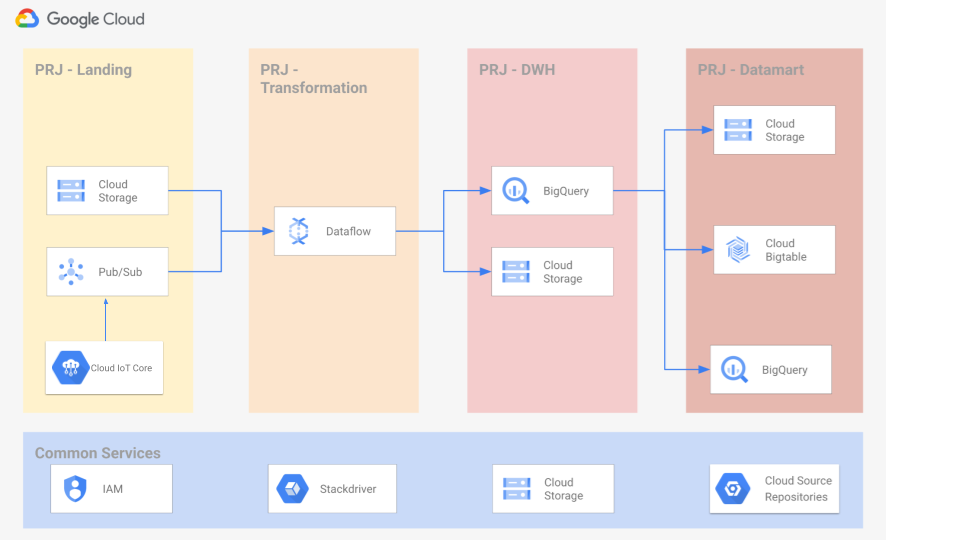|
|
||
|---|---|---|
| .. | ||
| README.md | ||
| diagram.png | ||
| diagram_iot.png | ||
| main.tf | ||
| outputs.tf | ||
| variables.tf | ||
README.md
Google Cloud IoT Core Module
This module sets up Cloud IoT Core Registry, registers IoT Devices and configures Pub/Sub topics required in Cloud IoT Core.
To use this module, ensure the following APIs are enabled:
- pubsub.googleapis.com
- cloudiot.googleapis.com
Simple Example
Basic example showing how to create an IoT Platform (IoT Core), connected to a set of given Pub/Sub topics and provision IoT devices.
Devices certificates must exist before calling this module. You can generate these certificates using the following command
openssl req -x509 -newkey rsa:2048 -keyout rsa_private.pem -nodes -out rsa_cert.pem -subj "/CN=unused"
And then provision public certificate path, together with the rest of device configuration in a devices yaml file following the following format
device_id: # id of your IoT Device
is_blocked: # false to allow device connection with IoT Registry
is_gateway: # true to indicate the device connecting acts as a gateway for other IoT Devices
log_level: # device logs level
certificate_file: # public certificate path, generated as explained in the previous step
certificate_format: # Certificates format values are RSA_PEM, RSA_X509_PEM, ES256_PEM, and ES256_X509_PEM
Example Device config yaml configuration
device_1:
is_blocked: false
is_gateway: false
log_level: INFO
certificate_file: device_certs/rsa_cert5.pem
certificate_format: RSA_X509_PEM
device_2:
is_blocked: true
is_gateway: false
log_level: INFO
certificate_file: device_certs/rsa_cert5.pem
certificate_format: RSA_X509_PEM
module "iot-platform" {
source = "./modules/iot-core"
project_id = "my_project_id"
region = "europe-west1"
telemetry_pubsub_topic_id = "telemetry_topic_id"
status_pubsub_topic_id = "status_topic_id"
protocols = {
http = false,
mqtt = true
}
devices_config_directory = "./devices_config_folder"
}
# tftest:skip
Now, we can test sending telemetry messages from devices to our IoT Platform, for example using the MQTT demo client at https://github.com/googleapis/nodejs-iot/tree/main/samples/mqtt_example
Example with specific PubSub topics for custom MQTT topics
If you need to match specific MQTT topics (eg, /temperature) into specific PubSub topics, you can use extra_telemetry_pubsub_topic_ids for that, as in the following example:
module "iot-platform" {
source = "./modules/iot-core"
project_id = "my_project_id"
region = "europe-west1"
telemetry_pubsub_topic_id = "telemetry_topic_id"
status_pubsub_topic_id = "status_topic_id"
extra_telemetry_pubsub_topic_ids = {
"temperature" = "temp_topic_id",
"humidity" = "hum_topic_id"
}
protocols = {
http = false,
mqtt = true
}
devices_config_directory = "./devices_config_folder"
}
# tftest:skip
Example integrated with Data Foundation Platform
In this example, we will show how to extend the Data Foundations Platform to include IoT Platform as a new source of data.
-
First, we will setup Environment following instructions in Environment Setup to setup projects and SAs required. Get output variable project_ids.landing as will be used later
-
Second, execute instructions in Environment Setup to provision PubSub, DataFlow, BQ,... Get variable landing-pubsub as will be used later to create IoT Registry
-
Now it is time to provision IoT Platform. Modify landing-project-id and landing_pubsub_topic_id with output variables obtained before. Create device certificates as shown in the Simple Example and register them in devices.yaml file together with deviceids.
module "iot-platform" {
source = "./modules/iot-core"
project_id = "landing-project-id"
region = "europe-west1"
telemetry_pubsub_topic_id = "landing_pubsub_topic_id"
status_pubsub_topic_id = "status_pubsub_topic_id"
protocols = {
http = false,
mqtt = true
}
devices_config_directory = "./devices_config_folder"
}
# tftest:skip
-
After that, we can setup the pipeline "PubSub to BigQuery" shown at Pipeline Setup
-
Finally, instead of testing the pipeline by sending messages to PubSub, we can now test sending telemetry messages from simulated IoT devices to our IoT Platform, for example using the MQTT demo client at https://github.com/googleapis/nodejs-iot/tree/main/samples/mqtt_example . We shall edit the client script cloudiot_mqtt_example_nodejs.js to send messages following the pipeline message format, so they are processed by DataFlow job and inserted in the BigQuery table.
const payload = '{"name": "device4", "surname": "NA", "timestamp":"'+Math.floor(Date.now()/1000)+'"}';
Or even better, create a new BigQuery table with our IoT sensors data columns and modify the DataFlow job to push data to it.
Variables
| name | description | type | required | default |
|---|---|---|---|---|
| devices_config_directory | Path to folder where devices configs are stored in yaml format. Folder may include subfolders with configuration files. Files suffix must be .yaml. |
string |
✓ | |
| project_id | Project were resources will be deployed | string |
✓ | |
| region | Region were resources will be deployed | string |
✓ | |
| status_pubsub_topic_id | pub sub topic for status messages (GCP-->Device) | string |
✓ | |
| telemetry_pubsub_topic_id | pub sub topic for telemetry messages (Device-->GCP) | string |
✓ | |
| extra_telemetry_pubsub_topic_ids | additional pubsub topics linked to adhoc MQTT topics (Device-->GCP) in the format MQTT_TOPIC: PUBSUB_TOPIC_ID | map(string) |
{} |
|
| log_level | IoT Registry Log level | string |
"INFO" |
|
| protocols | IoT protocols (HTTP / MQTT) activation | object({…}) |
{ http = true, mqtt = true } |
|
| registry_name | Name for the IoT Core Registry | string |
"cloudiot-registry" |
Outputs
| name | description | sensitive |
|---|---|---|
| iot_registry | Cloud IoT Core Registry |
